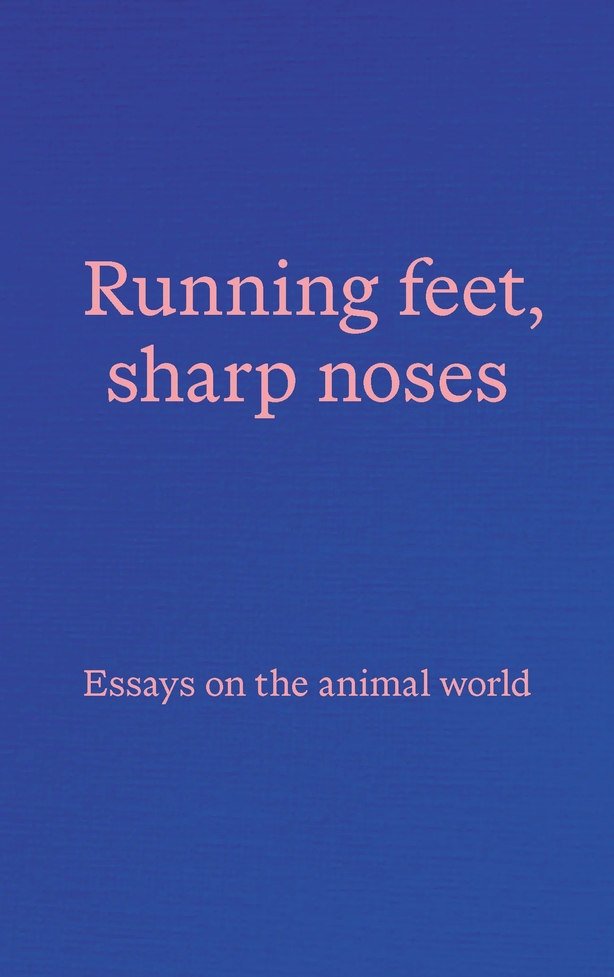We present an extract from the new anthology Running feet, sharp noses - read What's New, Pussycat? by June Caldwell below.
What is it about animals? – those creatures that keep us company, a figure in a memory or folktale, the shadowy presence in a photograph, or an ancient drawing on a wall. Guides, companions, imaginary beings, hindrances, sources of fear and love ...
Running feet, sharp noses is a collection of essays on the animal world. Each piece is a profound meditation on how animals affect our sense of self, our memories, our actions. This brilliant new book of non-fiction investigates – with the insights and perceptions of some of the finest writers at work today – how animals shape and determine our everyday lives, whether we realise it or not.
Contributors include Latifa Akay, Sara Baume, John Berger, June Caldwell, Niamh Campbell, Vona Groarke, Edward Hoagland, Tim MacGabhann, Sabrina Mandanici, Darragh McCausland, Honor Moore, Eileen Myles, Stephen Sexton, Sexton, Jessica Traynor, Erica Van Horn, and Suzanne Walsh.
What's New, Pussycat?
I can never get away from cats. They are there in my dreams, practising manipulation, being prize weirdos. And in my front garden also, chewing and rubbing their hormone-packed chins on the twenty-one Nepeta (catnip) bushes, getting rightly stoned. I am mum to two: Cloudy (8), who I adopted after being shown a photograph when drunk at a Panti show – High Heels in Low Places – in Vicar Street in 2014, and Zarko (7), who belonged to a neighbour but moved in with us six years ago. The day Cloudy arrived my mother and I were sick with nerves. My mother’s cat Minnie died in 1948 after being shot in the eye with an air gun in Inchicore by a nasty teen neighbour, and I’d never had a cat growing up as my father didn’t allow pets. We sat in the dining room on old brown tartan armchairs looking sideways at this tiny three-month-old grey-and-white ball of fluff. Cloudy would hide under the large dining table on a velvet chair and every few minutes she’d lift the tablecloth with her paw to look at us and assess her situation. This went on for weeks. It was a year before she trusted us. For two years the neighbour who originally adopted Zarko from Cats Aid called to the door demanding him back. 'You can’t legislate for where a cat chooses to go or live,’ I said. They don’t have a cat-flap, we do. Case closed. His house had a few dogs and kids; Zarko wanted a quiet(er) life and foolishly chose our place instead.
Cats also psychically hunt me down as soon as I have the audacity to leave home for longer than a day. During a recent trip to a writer’s retreat in the Loire Valley, I attempted to evade the forty-degree heat by visiting the Château d’Oiron, a sixteenth-century palace that is also a contemporary art gallery. The place is a mish-mash, with dozens of mid-sixteenth-century paintings among stucco plaster work showing the history of Troy and three episodes of the Aeneid by Virgil. There’s also a wave tower with a sci-fi floating hemisphere, a whirring robot that interprets objects on the unreachable-to-some upper floors, as well as other curios by at least seventy artists. I learn that the original owners were the Gouffier family, whose grandson Claude was the real-life inspiration for Charles Perrault’s Puss in Boots.
Claude Gouffier was an avid art collector who, in 1540, transformed Oiron from an ordinary castle to an incredible showy abode, creating an upper gallery for his own personal collection of oddities, a fifty-metre-long room to exhibit paintings and a round tower (where random items sit as part of a Marina Abramović performance piece in absentia). In 1551, King Henry II of France and his entire court were guests of Claude’s, who was granted the title Marquis de Caravaz for playing ball. Charles Perrault loosely disguised lucky Caravaz as ‘Marquis de Carabas’ in his story of the lying cat who always gets what he wants. As you know, Puss in Boots was an anthropomorphic fellow who used trickery and deceit to gain power and wealth, and the prestige of the ruling classes.

Zarko and Cloudy don’t get on, to put it mildly. He attacks her, is hideously jealous of her. She is disgusted by him, revolted even. She blames us for allowing him to live here. My partner and I have to keep both cats segregated 24/7. Zarko is locked in the sitting room at night, so Cloudy can come and go in peace from her back-garden hunts. During the day we lock her out until she appears at a window to be fed, so he can roam the house. We have a limited lifestyle because of this routine. My mother loved Cloudy but as she got older, the cat tired of her escalating frailty and now and then would hit her across the face. We wondered if Cloudy perceived old age as an evolutionary burden. By contrast, when my mother died in 2020, Zarko mourned her absence by refusing to roll on his back for seven months. Cats love to do this to show trust; how friendly and fun they are; how much they enjoy your company. Instead, he made daily visits to her bedroom to scream at her pillow. (One of the most common signs of cat grief is increased yowling.) Cloudy didn’t care. While she’s nocturnally affectionate, licking my chin or forehead during the witching hours – once I woke up simultaneously fainting when she was doing this – she is blatantly disinterested in people and especially children.
Growing up in Ballymun in the seventies, no one cared about cats. It was dogs all the way, followed by Top of the Pops, cardboard packets of reconstituted food, and fear of priests. There was just one cat on the road, Fairy Forde. His proprietor was a feminist (instrumental in maternity leave being introduced into Ireland) and some of the neighbours quipped about her needing a cat, i.e. being a witch. That long-held injurious association. Women + cat(s) = witch = unknown powers = ungodly. Fairy was a robust marmalade who spent his days watching us play, but never played with us. He had zero interest. Cats can’t be bothered so much of the time. They lack the cognitive skills to interpret human language, but they recognise when you talk to them and can also recognise the sound of their name. Cat behaviourists believe an adult feline’s intelligence is comparable to that of a two-year-old human toddler.
Cats stare. Cats stare at us. Cats stare at us and it makes us feel vulnerable. It unsettles us. Their eyes glow due to a mirror-like structure behind their retinas that enables them to have night vision. Cats stare at us at night and their eyes glow and it scares us because we cannot see in the dark. Or as one Washington Post journalist put it in yet another cat article in time for yet another Hallowe’en: ‘The glow is not the most unsettling thing about cats’ eyes. Unlike tigers and jaguars and other big cats, house cats have vertically slit pupils, a common feature among small nocturnal predators that hunt close to the ground. What else has vertically slit pupils and also occasionally hisses? The serpent. And who made his first biblical appearance as a snake? That’s right: Satan.’

June Caldwell is the author of the short story collection Room Little Darker and her debut novel, Little Town Moone, is forthcoming from John Murray. Running feet, sharp noses: Essays on the animal world is published by PVA Books.

